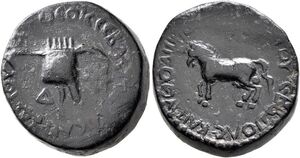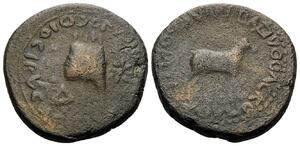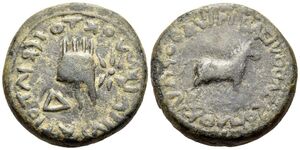Artaxias III 18-35 AD (Kov 189-191; 192-194)
Description
Lucius Antonius Zeno was the son of Polemo I, king of Pontus (ca. 37-8 BC) and his wife and successor, Pythodoris (ca. 8 BC—AD 23/4). He adopted the name Artaxias after he was crowned by Germanicus acting on the authority of the emperor Tiberius. Zeno-Artaxias (BNP [3]) was a devoted Armenophile and was well-received by the Armenian people. He died in AD 35 after an apparently peaceful reign.
Artaxias's coins have only recently been identified, and are unusual for a number of reasons. The first issue (Kov-189) depicts the jugate heads of Tiberius and Zeno, both laureate. On the reverse is an Armenian tiara and the legend "Caesar Tiberius and Zeno." Two questions are prompted by these coins. Why are both laureate, are the two celebrating a joint triumph? And why does the inscription use "Zeno" instead of "Artaxias"? Perhaps this issue predates Zeno's coronation.
The second issue is in the name of "King Artaxias." It does not bear a portrait of the king, but instead a tiara flanked by a star and the letter Δ. If the Δ is a denomination mark (Δ = 4 chalkoi) it is unprecedented in Armenian coinage. It is also possible to argue that Δ indicates "year 4" of Artaxias's reign. The reverse legend names Artaxias's parents; again an unprecedented occurrence in Armenian coinage. The obverse legend includes the names of the divine Augustus and Livia, an interesting parallel to the reverse legend. The unorthodox iconography (no portraits) and legend suggest a commemorative issue, perhaps on the occasion of Pythodoris's death which would then have occurred in AD 21/2.
Imitative Coinage of the Period 35-54 AD (No. 192-194)
Imitations of Artaxias III's tiara/horse coins appeared in the troubled period following his reign. These imitations are of mediocre quality engraving with the legends frequently rendered retrograde. However, in the badly blundered legends one can read BAΣ VOOΛ where BAΣ APTAXIOY occurs on the official coins. The temptation to suggest that Vologases was somehow responsible for this coinage would lead to placing their production (at least initially) after ca. AD 51, and probably into the first reign of Tiridates I, 52/3-60). Speculation aside, it is not possible at this point to assign exact authorship to these imitations (Kovacs 2014, 23-24). Approximately six contenders for Armenia's throne came and went during this period before Tiridates I became king in AD 52/3. They are listed below.
The legends on these imitations may vary from die to die. Only the major varieties are listed here.
Kovacs, Frank L. “Armenian Coinage in the Classical Period” CNS 10, Classical Numismatic Group, Lancaster, 2016, pp. 31-32.
Artaxias's coins have only recently been identified, and are unusual for a number of reasons. The first issue (Kov-189) depicts the jugate heads of Tiberius and Zeno, both laureate. On the reverse is an Armenian tiara and the legend "Caesar Tiberius and Zeno." Two questions are prompted by these coins. Why are both laureate, are the two celebrating a joint triumph? And why does the inscription use "Zeno" instead of "Artaxias"? Perhaps this issue predates Zeno's coronation.
The second issue is in the name of "King Artaxias." It does not bear a portrait of the king, but instead a tiara flanked by a star and the letter Δ. If the Δ is a denomination mark (Δ = 4 chalkoi) it is unprecedented in Armenian coinage. It is also possible to argue that Δ indicates "year 4" of Artaxias's reign. The reverse legend names Artaxias's parents; again an unprecedented occurrence in Armenian coinage. The obverse legend includes the names of the divine Augustus and Livia, an interesting parallel to the reverse legend. The unorthodox iconography (no portraits) and legend suggest a commemorative issue, perhaps on the occasion of Pythodoris's death which would then have occurred in AD 21/2.
Imitative Coinage of the Period 35-54 AD (No. 192-194)
Imitations of Artaxias III's tiara/horse coins appeared in the troubled period following his reign. These imitations are of mediocre quality engraving with the legends frequently rendered retrograde. However, in the badly blundered legends one can read BAΣ VOOΛ where BAΣ APTAXIOY occurs on the official coins. The temptation to suggest that Vologases was somehow responsible for this coinage would lead to placing their production (at least initially) after ca. AD 51, and probably into the first reign of Tiridates I, 52/3-60). Speculation aside, it is not possible at this point to assign exact authorship to these imitations (Kovacs 2014, 23-24). Approximately six contenders for Armenia's throne came and went during this period before Tiridates I became king in AD 52/3. They are listed below.
The legends on these imitations may vary from die to die. Only the major varieties are listed here.
Kovacs, Frank L. “Armenian Coinage in the Classical Period” CNS 10, Classical Numismatic Group, Lancaster, 2016, pp. 31-32.
Collection Tree
- ANCIENT
- Armenia Major
- Artaxias III 18-35 AD (Kov 189-191; 192-194)
- Armenia Major






